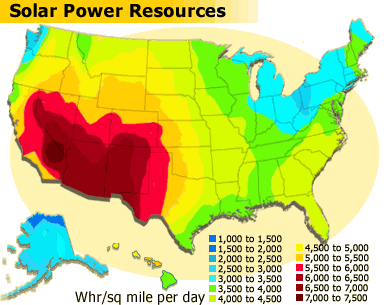

|
Solar Thermal |
|---|
In a world looking for more energy to meet growing demands, all the established forms and all the new forms of solar thermal energy and solar electricity are valid and important. As technology evolves there will continue to be a place for the existing established technologies.
Curved solar mirrors that concentrate sunlight don't work in cloudy weather, so they are best in the deserts where direct sunlight is at its highest level. These solar thermal concentrators have the advantage of being able to store a portion of the energy produced in large insulated tanks as heat and thereby smooth out variations due to clouds or to extend generation into the early night-time, or they can be operated 24 hours a day with alternative fuels (biomass, gas or oil) during non day-light hours, thus extending their economic viability. (See more details below.)
Stationary solar thermal panels and solar electric panels ("PV"), on the other hand, can be placed directly on buildings anywhere, from individual homes to large industrial plants, and they keep right on producing on a cloudy day. As natural gas prices continue to rise, solar hot water heaters will soon see a revival.
 Solar Thermal Electric:
Solar Thermal Electric:
"The U.S. manufacture of both solar thermal collector and photovoltaic (PV) cells and modules continued to grow at a strong pace in 2005. This occurred despite the fact that prices for solar panels and PV cells and modules rose due to material cost increases. The solar industry has been able to absorb most of the rising material costs because it has become more flexible in its production methods and supply arrangements over the past years. It has recovered from the nationwide economic downturn in 2003, showing significant growth in 2004 and 2005."Solar-Energy Co-operation -- Europe – Africa, African Development thru European Climate Stabilisation Efforts, by Dr. Gerhard Knies, Hamburger Klimaschutz-Fonds HKF, Formerly research physicist at DESY [2006 ]Domestic shipments of solar thermal collectors rose 10.4 percent to 14.7 million square feet in 2005 (Table 29). There were 25 companies shipping solar collectors in 2005, one more than in 2004. Total shipments rose to 16 million square feet, a 13.7 percent increase over 2004 (Table 30 and Figure F1). Exports surged 67.4 percent, while imports increased 22.1 percent (Table 30)."
"A solar power link can make the European obligations for GHG reduction to a motor for African development"
Economic, Energy, and Environmental Benefits of Concentrating Solar Power in California, by L. Stoddard, J. Abiecunas, and R. O'Connell, Black & Veatch, Overland Park, Kansas; in Collaboration with the Interfaith Environmental Council and the Coalition on the Environment and Jewish Life of Southern California, Los Angeles, California [2006 April]
This study provides a summary assessment of concentrating solar power (CSP) and its potential economic return, energy supply impact, and environmental benefits for the State of California. Emphasis was placed on in-state economic impact in terms of direct and indirect employment created by the manufacture, installation, and operation of CSP plants. The environmental impact of CSP relative to natural gas fueled counterparts was studied. The value of CSP as a hedge against natural gas price increases and volatility was also analyzed.
Why California Should Develop Its Solar Energy Resource [1.1 mb, pdf], by Solar Energy Industries Assn. (SEIA); Solar Thermal Power Division, The DOE Concentrating Solar Power (CSP) Program; SunLab, a virtual laboratory comprising groups at Sandia National Laboratories and the National Renewable Energy Laboratory (NREL) [2003 September 8]
California can add another engine for its economy by developing its solar energy resource. The economic benefits to California far exceed the cost to develop its clean and renewable resource....Approximately one third of one percent of California’s land could generate all of the state’s current electricity needs
How do we develop this resource?
- Concentrating Solar Technologies ("CSP") can be used to “mine” this resource.
- These technologies use curved mirrors to focus the sun’s rays and to make steam.
- This steam is used to produce electricity via conventional power equipment
- In multi-Megawatt plants, CSP provides the lowest cost solar electricity
 Click on image for photos of this installation |
|---|
"These solar facilities are referred to as "advantageous peak facilities," as they operate at their peak when it is sunniest, which is also when local power requirements are greatest, due to increased air conditioning demand... The facilities regulate their power supply through the use of supplemental natural gas-fueled electric generating plants.""A large Solar Field [could] be added on to an existing fossil fuel power plant. The solar fields can serve to boost the electricity and cogeneration capacity (power, heat and cooling) of any size plant. The temperature, flow rate, and pressure of a fossil fuel power plant can be enhanced with the addition of solar fields. Power plants are able to achieve cost savings as well as take a role in reducing global warming."
|
|
|
Solar Water Heating:
One of the leading solar water heater manufacturing companies is in California:
"SunEarth Inc., established in California in 1978, manufactures industry standard solar water heating collectors and systems for residential and commercial applications."